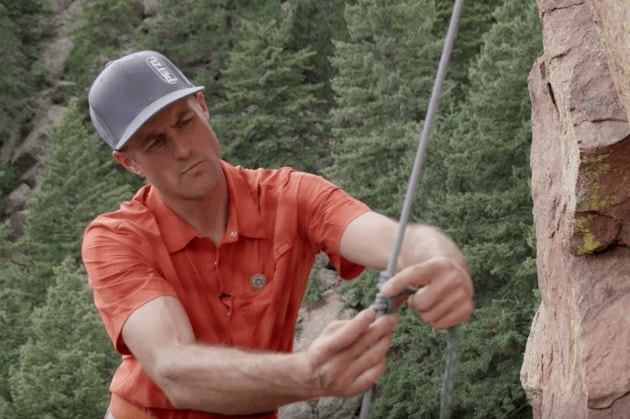Use this guide as a general overview. Remember, learning about rock climbing online serves as a tool, but in no way are videos or written articles a substitute for hands-on instruction. Failure to follow appropriate safety measures could result in serious injury or death. If just getting started, seek professional climbing courses offered by AMGA-certified guiding services. Be smart, and climb safe.
Friction hitches present a variety of important uses for climbing scenarios, including their ability to serve as a safety backup when rappelling, a means to escape a belay, and/or as a tool for ascending a fixed rope when emergencies beckon you to do so. For these reasons, friction hitches are an integral component to any climber’s technical skillset.
3 friction hitches every climber should know
A few of the most valuable friction hitches worth knowing how to tie and safely use include the auto-block, prusik, and Klemheist.
For any of these hitches, accessory cord of 5 to 7mm in diameter tied with a double fisherman’s knot works best. In certain instances, like with the Klemheist hitch, webbing (such as a nylon sling) will suffice, though not preferred. The length of your cord is based on personal preference and use, but a common diameter falls between 13.5 to 24in.
Another excellent option includes using the ever-growingly popular Auto Block or Hollow Block from Sterling
(check out this review for more details).
1. Auto-block (French prusik)
Most frequently used as a backup for rappelling, the auto-block (also referred to as the French prusik), is formed on the rope strands below the belay device and clipped to the leg or belay loop of your harness.
This hitch works as a backup to your rappel by adding friction that keeps you from an uncontrolled descent down the rope. An auto-block will slide while unloaded, allowing you to descend with control, but will lock on the rope when loaded. This is extremely vital should you accidentally let go while rappelling, or in moments when you need to use your hands for other tasks mid-rappel.
Due to its downward sliding mechanism and ease to release, the auto-block is not generally used to ascend ropes. In addition, it’s suggested to extend your rappel with any backup hitches. This provides added control and helps to avoid the possibility of it (or your clothing or hair) jamming into your belay device, which could negate your backup’s effectiveness.
Scroll down to find a video on how to tie the the auto-block.
2. Prusik (prussik)
This simple, yet strong multi-directional hitch offers more holding power than an auto-block and added versatility in its functionality that make it a crucial hitch to know. In fact, Yosemite Search and Rescue member, Buck Yedor doesn’t leave the ground without a prusik ready on his harness. The multi-directionality feature of the prusik means it will tighten on the rope in either direction of the pull.
Like an auto-block, the prusik (sometimes spelled prussik) can serve as a backup for rappelling; making it a useful tool for hands-free endeavors, such as coping with stuck ropes, cleaning gear, and rappelling down overhangs or across traverses.
Perhaps its more notable use, however, is the prusik’s ability to ascend a rope without the need of mechanical ascenders. Note: when ascending a rope, you should use two prusik cords/slings and should not attempt to ascend icy or wet ropes.
Here’s an overview at how you can use two prusiks to ascend a rope:
3. Klemheist (French Machard)
The Klemheist (also known as the French Machard) hitch offers virtually the same functionalities of the prusik (i.e. used as a backup or for ascending a rope).
Unlike the standard prusik, however, the Klemheist can be tied with webbing or cord and is uni-directional, meaning it can only be loaded by a pull from one direction. For this reason, it’s crucial to pay close attention to how you tie this hitch, making sure you set it to load on the rope from the proper direction.
Many prefer the Klemheist to the standard prusik, due to its comparative ease to tie/untie and slide on the rope, as well as its strong holding power.
How to tie an auto-block, prusik, and Klemheist
Now that you understand that differences between these useful friction hitches, let’s take a look at how to tie them.
In the video below, AMGA Instructor Team Member Patrick Ormond demonstrates how to the tie the auto-block, standard prusik, and Klemheist friction hitches.
Explore More
Related articles you'll loveToday’s Best Rock Climbing Gear Deals
200+ rock climbing videos
Strategies for Safer Rappelling
Video: Above the Fray—Beth Rodden on Climbing, Vulnerability, and Motherhood
Why You Shouldn’t Use a Daisy Chain for a Personal Anchor
Gear You Ought to Know: Sterling Rope’s Hollow Block
Climber Spotlight: Beth Rodden on Redpointing Tips, Training, and Nutrition
The Best Way to Belay from Above
How to Build Your First Trad Rack
Gear You Ought to Know: A Review of Metolius Ultralight Master Cams
Climber Confessional: A Lesson in Backing Up Your Systems
How to Rappel if You Drop Your Belay Device
Climbing Rope Management During Rappel
10 Dos & Don’ts of Multi-Pitch Climbing
Get daily updates by Liking us on Facebook
Free rock climbing PDFs on technique, training, knots, and more








